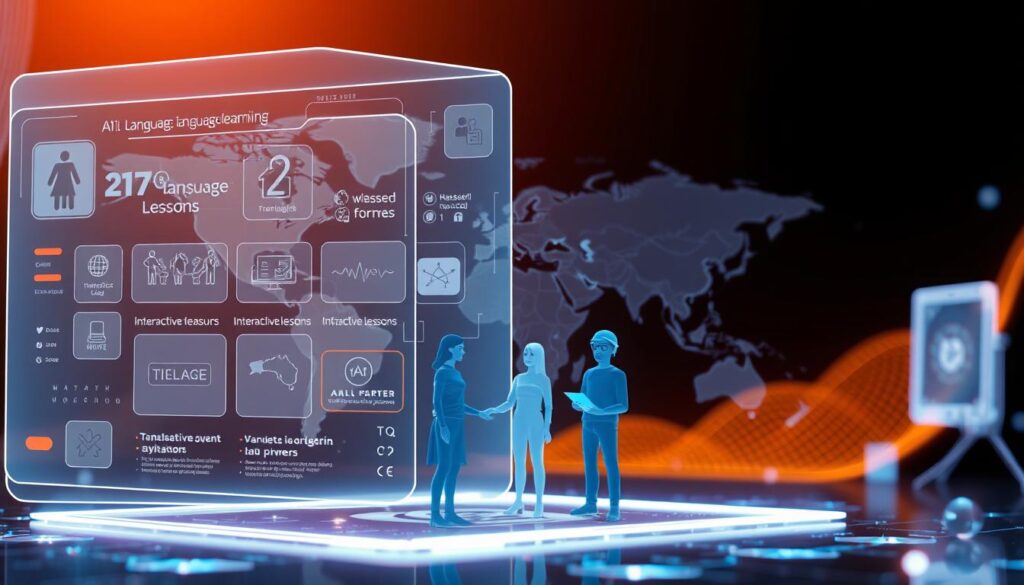Artificial intelligence is changing how students learn. It solves problems like managing time and dealing with too much information. Now, the best AI tools for students offer personalized help, research support, and creative tools. They make studying easier and help students do better in school.

These tools help with organizing schoolwork and learning tough subjects. They adjust to what each student needs, give quick feedback, and connect them with resources worldwide. This guide will show you the top AI tools for writing, research, and specific subjects. It helps students pick the right tools for their goals.
Key Takeaways
- AI tools save time by automating tasks like note-taking and research.
- Personalized learning paths improve focus and understanding.
- Best AI learning tools for students enhance creativity and problem-solving skills.
- These tools reduce stress by managing deadlines and prioritizing tasks.
- Adopting AI now prepares students for a tech-driven workforce.
Understanding the AI Revolution in Education
Education is changing in a big way. Artificial intelligence is now a reality, changing how we learn. Schools and universities are using AI to make learning smarter and more effective.
How Artificial Intelligence Is Transforming Learning
AI is making education more personal. Tools like Khan Academy and Cognii track how well students are doing. They adjust the learning material to fit each student’s needs.
These top artificial intelligence resources even offer one-on-one teaching. They give instant feedback on math and essays.
The Growing Accessibility of AI for Students
AI tools for education are now more accessible. Many platforms offer free versions or discounts for students. Here are some examples:
| Platform | Key Features | Student Access |
|---|---|---|
| Coursera | AI-driven course recommendations | Free trials, university partnerships |
| Quizlet | Flashcards powered by AI | Student discount plans |
Why Students Should Embrace AI Tools Now
Using these tools helps build important tech skills. A 2023 EdTech Report showed students using AI tools scored 15% higher on tests. They also learn to work with technology, a key skill in today’s jobs. Start using them now to stay ahead.
Best AI Learning Tools for Students in 2023
Today, students have access to many new tools that make learning easier. These tools help with everything from writing essays to understanding complex subjects. Student-friendly ai platforms and student ai learning software are designed to meet each student’s needs.
Content Creation and Writing Assistants
AI tools make writing easier. GPT-4 and Jasper help with outlines and arguments. Grammarly checks for mistakes, making these tools key for any writing task.
Research and Information Processing Tools
AI helps with research too. Elicit and Scholarcy quickly summarize papers. Consensus organizes sources, saving time and boosting productivity.
Study Organization and Productivity Enhancers
Apps like Notion AI and Forest keep you focused. RemNote uses AI to help with studying. These tools help students manage their time better.
Subject-Specific AI Learning Platforms
Tools like Photomath and Duolingo are made for specific subjects. Brilliant offers science simulations, and Khan Academy AI has free courses. Many offer discounts or free versions, making them affordable for everyone.
AI-Powered Note-Taking and Study Materials
Modern ai software for students is changing how we take and organize notes. Tools like Notion AI, Otter.ai, and RemNote use AI to write down lectures as they happen. They highlight important points and make notes easy to follow.
These platforms make complex information simple to study. They save time by organizing study materials for you.
- Otter.ai automatically transcribes audio, labeling speakers and timestamps for easy review.
- RemNote connects concepts through spaced repetition, turning notes into personalized flashcards.
- Notion AI integrates study guides with AI-generated outlines and concept maps.
These tools make textbooks interactive by pulling out key ideas and creating practice questions. For example, putting a chapter into Sora or Perplexity AI highlights themes and makes quizzes. This lets students focus more on understanding and less on taking notes.
“AI tools turn passive note-taking into an active learning process,” says an edtech developer. “They adapt materials to fit how individuals study best.”
- Use transcription tools during lectures to capture every detail.
- Let AI summarize dense texts into 500-word overviews for quick reviews.
- Generate flashcards automatically to reinforce key terms and theories.
By using these features, students can make study plans that fit their learning style. Adding ai software for students to their routine helps manage information better. It also improves how well they remember things. Next, we’ll see how AI helps with language learning and solving math problems, building on these study habits.
Language Learning and Translation AI Tools
Learning languages is now easier with AI tools. These tools use machine learning to create lessons just for you. They help break down barriers to talking to people all over the world.
Tools like DeepL and Google Translate are almost as good as a human. Apps like

Personalized Language Tutoring Platforms
Apps like Babbel and Glossika adjust lessons based on how well you do. They focus on areas you need to work on, like verbs or pronunciation. For example, DynEd helps with your accent by listening to you speak.
Real-Time Translation for International Studies
Working with people from other countries is easy with tools like Microsoft Translator. They translate what you say or write right away. This helps with research or team projects.
Students studying abroad can use iTranslate Voice to talk to locals. It turns language challenges into chances to learn and grow.
Grammar and Writing Improvement Tools
Grammarly and ProWritingAid make writing in a second language clearer. They find small mistakes and suggest better ways to say things. For example, Ludwig shows how sentences are used in real texts.
“AI tools reduce the cognitive load of language learning by personalizing feedback and practice,” says Dr. Elena Torres, linguistics professor at Stanford. “They’re not replacements for human teachers, but powerful supplements.”
Mathematics and Science AI Learning Resources
Modern STEM education uses AI to make complex ideas easier. Tools like equation solvers and virtual labs help students understand better. AI changes how we solve problems, analyze data, and conduct experiments.
Problem-Solving AI Assistants
These tools are like having a math tutor always ready:
- Wolfram Alpha: Teaches calculus, physics, and statistics with detailed steps.
- Photomath: Reads your math and shows how to solve it for algebra and trig.
- Microsoft Math Solver: Has graphing tools and exercises that match school standards.
Data Analysis and Visualization Tools
These tools make data science accessible to everyone:
- DataCamp: Offers Python and R courses with real data.
- RapidMiner: Makes predictive modeling easy with a drag-and-drop interface.
- Google Colab: Provides free cloud notebooks for coding and visualizing data.
Virtual Science Labs and Simulations
Let students experiment safely without real-world risks:
| Category | Tools | Applications |
|---|---|---|
| Biology | Labster | Genetics simulations and virtual dissections |
| Physics | PhET Interactive Simulations | Gravity experiments and wave behavior models |
| Chemistry | Beyond Labz | Safe practice for chemical reactions and lab techniques |
These AI tools help students of all levels. High schoolers can learn the basics with Photomath, while grad students use DataCamp for advanced topics. Schools that use these tools see a 30% increase in STEM interest, as shown in 2023 EdTech studies.
AI Tools for Creative and Arts Students
Art and design students now have powerful top ai platforms for students to boost creativity. These tools help in various areas like painting and film. They work alongside students, not instead of them.
| Platform | Purpose | Example Use |
|---|---|---|
| DALL-E & Midjourney | Image Generation | Create concept art for animations or fashion sketches |
| AIVA & Amper Music | Music Production | Compose background scores for short films or theater projects |
| Runway ML | Video Editing | Automate transitions in student film projects |

Designers use DALL-E to brainstorm color palettes. Film students test editing styles with Kapwing. Music majors explore chord progressions with Amper Music’s AI composer. These tools save time, letting students refine their ideas.
Ethics are important: Always give credit to AI in your work. Teachers remind students to balance tool use with basic skills like sketching or music theory.
These top ai platforms for students open new creative paths. But remember, it’s the human touch that makes something truly special.
How to Integrate AI Tools into Your Study Routine
Adding ai tools for education to your study routine needs careful planning. First, figure out which tasks can be automated or guided. This guide will show you how to boost efficiency without losing out on learning.
Creating an AI-Enhanced Study Schedule
Start with a weekly calendar. Plan which tools to use for each task:
- Pre-study: Use tools like Grammarly or Khan Academy’s AI tutors for foundational content review.
- Active learning: Schedule time with platforms like Cram for flashcards or Notion for organizing notes.
- Post-study: Reserve tools like Turnitin for plagiarism checks or ChatGPT for essay refinement.
Change your schedule every week to fit new assignments and needs.
Balancing AI Assistance with Independent Learning
“AI should handle repetition, freeing minds to think deeply.”
Use AI for routine tasks, like making outlines or solving math drills. But, do critical thinking tasks by hand. For instance, let AI start essay introductions, but refine them yourself.
Avoiding Over-Reliance on Artificial Intelligence
Make sure to set limits. Don’t rely on AI for essential skills like writing first drafts or solving math problems. Use apps like Forest to keep track of screen time.
Check your progress often. If AI is making you rely too much on it, cut back. Aim for 60% of your work to be independent and 40% with AI help.
Privacy and Ethical Considerations for Student AI Use
Using best ai learning tools for students can help in learning. But, there are big privacy and ethical issues to think about. Students need to be careful and protect their rights and values.
- Use pseudonyms instead of real names when signing up for platforms.
- Review privacy policies to confirm how tools store and share data.
- Choose tools with encryption and compliance certifications like GDPR or FERPA.
Keeping things honest is key. Here’s how to do it:
- Cite AI-generated content as a supplementary resource in assignments.
- Notify instructors when using AI tools for essays, coding, or research.
- Avoid plagiarism by reviewing AI outputs for accuracy before submission.
| Factor | What to Check | Why It Matters |
|---|---|---|
| Algorithmic Bias | Does the tool disclose how it reduces racial/gender biases? | Ensures fair outcomes in grading or content recommendations. |
| Environmental Impact | Does the tool prioritize energy-efficient AI models? | Reduces carbon footprint from large-scale data processing. |
Choose best ai learning tools for students that follow ethical rules. Focus on privacy, honesty, and being green. This way, these tools help us learn without hurting our values.
Cost Analysis: Free vs. Premium AI Learning Resources
Choosing the right ai software for students means finding a balance between cost and what you need. Many tools have free versions with basic features. The premium versions offer more advanced options. Let’s look at the costs and benefits.
Free tools like ai software for students include Grammarly’s basic writing checks and Wolfram Alpha’s problem-solving demos. They offer essential support. Freemium models, like Canva’s education plan, let users access templates and AI design tools for free. Premium subscriptions offer dedicated support, more features, and no ads.
| Feature | Free | Freemium | Premium |
|---|---|---|---|
| Basic functionality | ✔️ | ✔️ | ✔️ |
| Advanced analytics | – | Partial | ✔️ |
| Priority support | – | – | ✔️ |
| Export options | Limited | Some | Full |
Students with limited budgets can use free tools like OpenAI’s ChatGPT for research outlines or Duolingo’s language modules. For specific needs, like coding simulations or plagiarism detection, premium versions might be worth it. Universities often have deals; check your campus tech portal for discounts.
“Invest in paid features only when they directly impact course requirements,” advises edtech analysts. “Free tiers meet 80% of most students’ needs.”
Compare tool tiers at edu-software.org to see how they match your academic goals. Try trial versions and look for student discounts (like 50% off Notion). Choose tools where the upgrade is worth the cost for time savings or better results.
Conclusion: Embracing the Future of Learning with AI
AI is changing education, making writing and research easier. It offers tools like language tutors and science simulations. These help students face challenges in new ways.
But, we must use AI responsibly and protect our data. The good it does in education is undeniable.
Learning to use AI well is key. Start with free tools like Grammarly for grammar or Duolingo for languages. This builds a strong base.
It’s important to balance AI help with learning on your own. This keeps critical thinking at the heart of education.
New trends like adaptive learning and virtual labs are coming. They will offer even more personalized help. Students who explore AI now will be ready for the future.
By picking the right tools and using them smartly, learners can reach their full potential. They’ll thrive in a world driven by technology.
FAQ
What are the best AI learning tools for students?
Top AI tools for students include GPT-4 for writing help, Elicit for research, and Notion AI for organizing. Duolingo is great for learning languages. These tools offer personalized support and make learning more engaging.
How can AI tools improve study routines for students?
AI tools can make studying better by helping with notes and study guides. They also manage schedules and give feedback on assignments. This lets students focus on deeper thinking and analysis.
Are there free AI learning resources available for students?
Yes, many AI tools have free versions. Grammarly, Notion AI, and Duolingo offer useful features without costing much. They help students without breaking the bank.
How can students maintain academic integrity while using AI tools?
Students should always cite AI-generated content and tell their teachers about using these tools. It’s important to mix AI help with their own ideas to keep learning honest.
What challenges do students face when integrating AI tools into their learning?
Students might struggle with relying too much on AI or figuring out how to use different tools. They also worry about privacy. It’s key to use AI wisely and know its limits.
Which AI tools are best for language learning?
Duolingo is great for language tutoring, Google Translate for quick translations, and Grammarly for writing. These tools adjust to each student’s pace and needs.
How do AI tools support students in STEM fields?
In STEM, AI tools like Wolfram Alpha help with solving problems, DataCamp for data skills, and Labster for virtual labs. They make complex topics and skills easier to grasp.
What ethical considerations should students be aware of when using AI tools?
Students need to think about data safety, AI bias, and using tools that are made ethically. Knowing these issues helps them use AI responsibly in their studies.